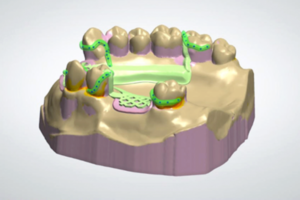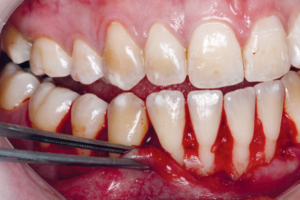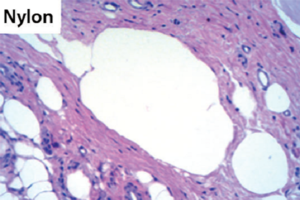AUTORES
Lorena Gonçalves Alexandrino
Mestranda em Implantodontia – Ilapeo. Orcid: 0000-0002-0557-8093.
Gustavo Eduardo Casagrande
Mestrando em Implantodonia – Ilapeo. Orcid: 0000-0002-1996-1237.
Stephanie Gomes Assunção Alves
Mestranda em Implantodontia – Ilapeo. Orcid: 0000-0002-5912-7124.
Élcio Marcantonio Jr.
Professor titular de Periodontia e Implantodontia – FOAr/Unesp. Orcid: 0000-0003-1294-2305.
RESUMO
O objetivo deste relato de caso foi avaliar se o momento cirúrgico para realizar o enxerto gengival livre (EGL) interfere no resultado da técnica para obtenção de gengiva inserida ao redor de implantes dentários. No primeiro caso clínico, antes da instalação dos implantes dentários, optou-se por realizar o EGL para aumentar a faixa de tecido ceratinizado na região. No segundo caso clínico, os implantes já estavam instalados e apresentavam uma faixa de gengiva inserida insuficiente, sendo assim necessária a cirurgia de EGL. Os dois casos de EGL foram realizados seguindo a mesma técnica cirúrgica. Após as cirurgias, uma ampla faixa de tecido queratinizado foi apresentada ao redor dos implantes, em ambos os casos. Contudo, cada situação clínica deve ser avaliada individualmente, sendo que a preferência e experiência do profissional devem ser levadas em consideração na escolha do momento cirúrgico para a execução da cirurgia, obtendo dessa forma o sucesso desejado no tratamento.
Palavras-chave – Implantes dentários; Tecido conjuntivo/ transplantação; Estética dental.
ABSTRACT
The objective of this case report was to evaluate whether the surgical time to perform the free gingival graft (FGG) interferes with the result of the technique for obtaining attached gingiva around dental implants. In the first clinical case, before the installation of dental implants, it was decided to perform FGG to increase the width of keratinized tissue in the region. In the second clinical case, the implants were already installed, and had an insufficiently attached gingival band, thus requiring FGG surgery. The two cases of FGG were performed following the same surgical technique. After the surgeries, a wide band of keratinized tissue was presented around the implants, in both cases. However, each clinical situation must be evaluated individually, and the preference and experience of the professional must be taken into account when choosing the surgical moment to perform the surgery, thus obtaining the desired success in the treatment.
Key words – Dental implants; Connective tissue/transplantation; Dental aesthetics.
Referências
- Knöfler W, Barth T, Graul R, Krampe D. Retrospective analysis of 10,000 implants from insertion up to 20 years-analysis of implantations using augmentative procedures. Int J Implant Dent 2016;2(1):25.
- Roccuzzo M, Gaudioso L, Bunino M, Dalmasso P. Long-term stability of soft tissues following alveolar ridge preservation: 10-year results of a prospective study around nonsubmerged implants. Int J Periodontics Restorative Dent 2014;34(6):795-804.
- Thoma DS, Naenni N, Figuero E, Hämmerle CH, Schwarz F, Jung RE et al. Effects of soft tissue augmentation procedures on peri-implant health or disease: a systematic review and meta-analysis. Clin Oral Implants Res 2018;29(suppl.15):32-49.
- Hermann JS, Buser D, Schenk RK, Cochran DL. Crestal bone changes around titanium implants. A histometric evaluation of unloaded non-submerged and submerged implants in the canine mandible. J Periodontol 2000;71(9):1412-24.
- Tarnow DP, Cho SC, Wallace SS. The effect of inter-implant distance on the height of inter-implant bone crest. J Periodontol 2000;71(4):546-9.
- Tarnow D, Elian N, Fletcher P, Froum S, Magner A, Cho SC et al. Vertical distance from the crest of bone to the height of the interproximal papilla between adjacent implants. J Periodontol 2003;74(12):1785-8.
- Grunder U, Gracis S, Capelli M. Influence of the 3D bone-to-implant relationship on esthetics. Int J Periodontics Restorative Dent 2005;25(2):113-9.
- Chen ST, Darby IB, Reynolds EC. A prospective clinical study of non-submerged immediate implants: clinical outcomes and esthetic results. Clin Oral Implants Res 2007;18(5):552-62.
- Pereira AG, Soares PV, Zeola LF, Machado AC, Teixeira DNR, Ribeiro CP et al. Enxerto de tecido conjuntivo subepitelial otimizando a reabilitação oral com implantes osseointegrados. PerioNews 2015;9(1):57-61.
- Frizzera F, Oliveira GP, Shibli JA, Moraes KC, Marcantonio EB, Marcantonio Jr. E. Treatment of peri-implant soft tissue defects: a narrative review. Braz Oral Res 2019;33(suppl.1)-e073.
- Evans CDJ, Chen ST. Esthetic outcomes of immediate implant placements. Clin Oral Implants Res 2008;19(1):73-80.
- Bassetti M, Kaufmann R, Salvi GE, Sculean A, Bassetti R. Soft tissue grafting to improve the attached mucosa at dental implants: a review of the literature and proposal of a decision tree. Quintessence Int 2015;46(6):499-510.
- Shibli JA, D’avila S, Marcantonio Jr. E. Connective tissue graft to correct peri-implant soft tissue margin: a clinical report. J Prosthet Dent 2004;91(2):119-22.
- Adell R, Lekholm U, Rockler B, Brånemark PI, Lindhe J, Eriksson B et al. Marginal tissue reactions at osseointegrated titanium fixtures (I). A 3-year longitudinal prospective study. Int J Oral Maxillofac Surg 1986;15(1):39-52.
- Zarb GA, Schmitt A. The longitudinal clinical effectiveness of osseointegrated dental implants: the Toronto study. Part III: problems and complications encountered. J Prosthet Dent 1990;64(2):185-94.
- Bengazi F, Wennström JL, Lekholm U. Recession of the soft tissue margin at oral implants. A 2-year longitudinal prospective study. Clin Oral Implants Res 1996;7(4):303-10.
- Lekholm U, Adell R, Lindhe J, Brånemark PI, Eriksson B, Rockler B et al. Marginal tissue reactions at osseointegrated titanium fixtures. (II) A cross-sectional retrospective study. Int J Oral Maxillofac Surg 1986;15(1):53-61.
- Strub JR, Gaberthuel TW, Grunder U. The role of attached gingiva in the health of peri-implant tissue in dogs. Clinical findings. Int J Periodontics Restorative Dent 1991;11(4):317-33.
- Wennström JL, Bengazi F, Lekholm U. The influence of the masticatory mucosa on the peri-implant soft tissue condition. Clin Oral Implants Res 1994;5(1):1-8.
- Block MS, Gardiner D, Kent JN, Misiek DJ, Finger IM, Guerra L et al. Hydroxyapatite-coated cylindrical implants in the posterior mandible: 10-year observations. Int J Oral Maxillofac Implants 1996;11(5):626-33.
- Warrer K, Buser D, Lang NP, Karring T. Plaque-induced peri-implantitis in the presence or absence of keratinized mucosa. An experimental study in monkeys. Clin Oral Implants Res 1995;6(3):131-8.
- Lin GH, Chan HL, Wang HL. The significance of keratinized mucosa on implant health: a systematic review. J Periodontol 2013;84(12):1755-67.
- Park WB, Kang KL, Han JY. Long-term clinical and radiographic observation of periimplant tissues after autogenous soft tissue grafts: a 15-year retrospective study. Implant Dent 2017;26(5):762-9.
- Berglundh T, Armitage G, Araujo MG, Avila-Ortiz G, Blanco J, Camargo PM et al. Peri-implant diseases and conditions: consensus report of workgroup 4 of the 2017 World Workshop on the classification of periodontal and peri-implant diseases and conditions. J Periodontol 2018;89(suppl.1):S313-8.
- Rescala B, Vidal F, Rosalem Jr. W, Silveira BM. Enxerto gengival livre para ganho de tecido queratinizado prévio à instalação de implante na região posterior de mandíbula: relato de caso com três anos de acompanhamento. ImplantNewsPerio 2018;3(1):58-64.
- Thoma DS, Buranawat B, Hämmerle CH, Held U, Jung RE. Efficacy of soft tissue augmentation around dental implants and in partially edentulous areas: a systematic review. J Clin Periodontol 2014;4(suppl.15):S77-91.





